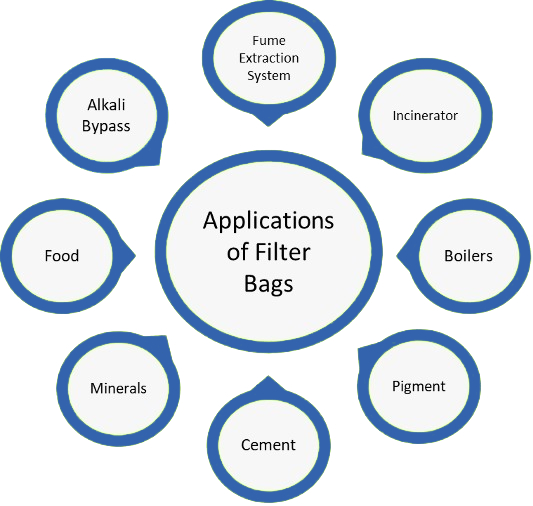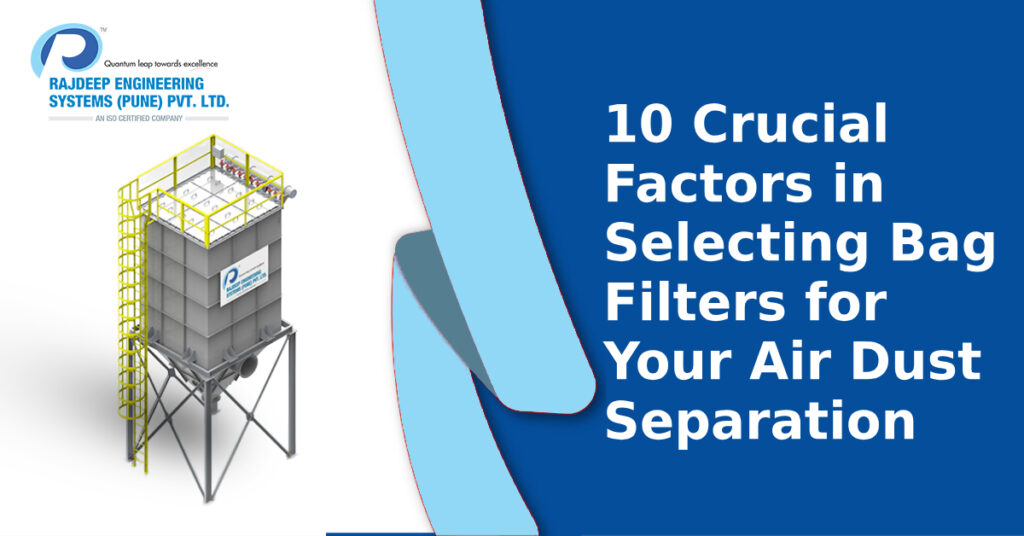The selection of bag filters is a critical aspect of dust collector design and operation, as it directly impacts the efficiency and longevity of the system. The choice of bag filter material or fabric media must align with the physical and chemical characteristics of the gas stream and system conditions to achieve optimal emissions control. Proper selection can reduce emissions to as low as 10mg/cm through effective filtration.
A pulse-jet dust collector typically consists of isolated compartments housing rows of fabric bags, either cylindrical or pleated cartridges. Dust-laden air passes through the outer surface of the bags and then radially through the filter media. Particles are captured on the upstream side of the bag filters, while the cleaned gas is released into the atmosphere. Each row of filter bag undergoes pulsing when the pressure drop exceeds a set limit, releasing collected material into the hopper for discharge through a Rotary Airlock Valve (RAL). The dust cake formed on the fabric is crucial, contributing to high efficiency with particle removal rates up to 99.9% for micron-sized particles.
Key Factors in Bag Filter Selection:
- Particle Characteristics: Size, moisture content, and abrasiveness.
- Operating Temperature: The bag filter material is compatible with operating temperatures.
- Dust Type: Nature of the particulate matter being collected.
- Chemical Compatibility: Resistance of the bag filter fabric to chemical exposure.
- Particle Size Distribution: Range of particle sizes present in the dust.
- Fiber Permeability: The ability of the fabric to allow air to pass through while capturing particles.
- Abrasive Properties: Resistance of the fabric to wear from dust particles.
- Installation Requirements: Ease of installation and maintenance.
- Cleaning Efficiency: Fabric’s ability to release dust during cleaning cycles.
- Flexibility: Capability of the fabric to stretch or ripple without damage.
Best Suited Bag Filter Fabrics:
Various bag filter fabrics are available for pulse-jet bag filters, including Polyester, Polypropylene, Acrylic, PTFE, Aramid, Ryton, glass fiber, and Ceramics. These fabrics may feature specialized coatings tailored to specific applications, such as high temperatures or aggressive chemical environments. For instance, glass fiber bags are ideal for temperatures up to 260°C, while other coatings enhance performance in moist or explosive atmospheres.
Types of Bag Filter Fabric Construction:
- Non-Woven: Entangled fibers suitable for aggressive applications like pulse-jet bag filters.
- Woven: Uniformly patterned threads affecting fabric strength and filtration efficiency, suitable for less intense cleaning methods.
Specialized Treatments on Bag Filters:
- PTFE Membrane: Enhances filtration efficiency and dust cake release.
- Singed: Exposes fiber ends to flame to prevent dust adhesion.
- Calendering: Smooth fabric surface to improve dust release.
- Fire Retardant: Reduces the risk of sparks igniting filter media.
- Acid Resistant: Enhances fabric’s resistance to acidic environments.
- Antistatic: Incorporates stainless steel grid for static dissipation, minimizing product contamination risks.
Applications of Bag Filters:

Conclusion:
Choosing the right filter bag is crucial for ensuring optimal dust separation, system efficiency, and compliance with environmental standards. The selection process must consider various factors like dust type, operating temperature, and fabric durability. With options like woven and non-woven fabrics and specialized treatments such as PTFE membranes and fire retardants, the right combination can significantly improve filtration performance.
For over 25 years, Rajdeep Engineering has been at the forefront of providing high-quality filter bags and customized solutions to meet diverse industrial requirements. With a commitment to innovation and customer satisfaction, Rajdeep Engineering ensures that every dust collection system is tailored for maximum efficiency and longevity.

